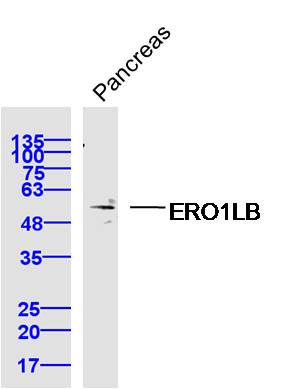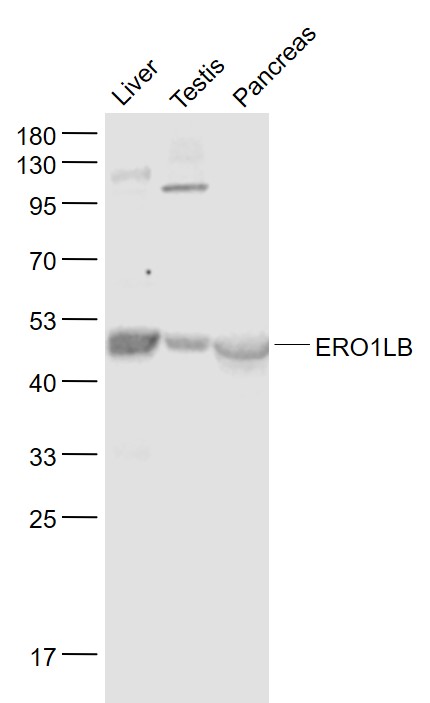
Rabbit Anti-ERO1LB antibody
Endoplasmic oxidoreductin-1-like protein B; ERO1-L-beta; ERO1B_HUMAN; ERO1-like protein beta; Oxidoreductin-1-L-beta.
View History [Clear]
Details
Product Name ERO1LB Chinese Name Ero1-Lβ蛋白抗体 Alias Endoplasmic oxidoreductin-1-like protein B; ERO1-L-beta; ERO1B_HUMAN; ERO1-like protein beta; Oxidoreductin-1-L-beta. literatures Research Area Cell biology Signal transduction Transporter Immunogen Species Rabbit Clonality Polyclonal React Species Mouse, (predicted: Human, Rat, Rabbit, Guinea Pig, ) Applications WB=1:500-2000 ELISA=1:5000-10000
not yet tested in other applications.
optimal dilutions/concentrations should be determined by the end user.Theoretical molecular weight 50kDa Cellular localization cytoplasmic Form Liquid Concentration 1mg/ml immunogen KLH conjugated synthetic peptide derived from human ERO1LB: 1-100/467 Lsotype IgG Purification affinity purified by Protein A Buffer Solution 0.01M TBS(pH7.4) with 1% BSA, 0.03% Proclin300 and 50% Glycerol. Storage Shipped at 4℃. Store at -20 °C for one year. Avoid repeated freeze/thaw cycles. Attention This product as supplied is intended for research use only, not for use in human, therapeutic or diagnostic applications. PubMed PubMed Product Detail Essential oxidoreductase that oxidizes proteins in the endoplasmic reticulum to produce disulfide bonds. Acts by oxidizing directly P4HB/PDI isomerase through a direct disulfide exchange. Does not act as a direct oxidant of folding substrate, but relies on P4HB/PDI to transfer oxidizing equivalent. Associates with ERP44 but not with GRP54, demonstrating that it does not oxidize all PDI related proteins and can discriminate between PDI and related proteins. Its reoxidation probably involves electron transfer to molecular oxygen via FAD. Acts independently of glutathione. May be responsible for a significant proportion of reactive oxygen species (ROS) in the being a source of oxidative stress. Required for the folding of cell, thereby being a source of oxidative stress.
Function:
Oxidoreductase involved in disulfide bond formation in the endoplasmic reticulum. Efficiently reoxidizes P4HB/PDI, the enzyme catalyzing protein disulfide formation, in order to allow P4HB to sustain additional rounds of disulfide formation. Other protein disulfide isomerase family members can also be reoxidized, but at lower rates compared to P4HB, including PDIA2 (50% of P4HB reoxidation rate), as well as PDIA3, PDIA4, PDIA6 and NXNDC12 (<10%). Following P4HB reoxidation, passes its electrons to molecular oxygen via FAD, leading to the production of reactive oxygen species (ROS) in the cell. May be involved in oxidative proinsulin folding in pancreatic cells, hence may play a role in glucose homeostasis.
Subunit:
Homodimer; disulfide-linked. Heterodimer with ERO1L; disulfide-linked. Also detected as monomer. Homodimers may be somewhat less active than monomers. Interacts with P4HB. Interacts with ERP44.
Subcellular Location:
Endoplasmic reticulum membrane; Peripheral membrane protein; Lumenal side. Note: The association with ERP44 may be essential for its retention in the endoplasmic reticulum.
Tissue Specificity:
Highly expressed in the digestive tract, including the duodenum and lower digestive tract. In the stomach, highly expressed in enzyme-producing chief cells (at protein level). In the pancreas, expressed in islets of Langerhans and, at lower levels, in enzyme-secreting cells (at protein level). Detected at low level in many other tissues.
Post-translational modifications:
N-glycosylated.
The Cys-90/Cys-95 and Cys-393/Cys-396 disulfide bonds constitute the redox-active center. The Cys-90/Cys-95 disulfide bond accepts electron from P4HB and funnel them to the active site disulfide Cys-393/Cys-396. The Cys-81/Cys-390 disulfide bond may be critical for structural stability. Two long-range disulfide bonds participate in loose feedback regulation. The Cys-90/Cys-130 disulfide bond may be the predominant regulatory switch to modulate the catalytic activity, while the Cys-100/Cys-262 disulfide bond may play an auxiliary regulatory role.
Similarity:
Belongs to the EROs family.
SWISS:
Q86YB8
Gene ID:
56605
Database links:Entrez Gene: 56605 Human
SwissProt: Q86YB8 Human
Product Picture
Primary: Anti-ERO1LB (SL14627R) at 1/300 dilution
Secondary: IRDye800CW Goat Anti-Rabbit IgG at 1/20000 dilution
Predicted band size: 50 kD
Observed band size: 50 kD
Bought notes(bought amounts latest0)
No one bought this product
User Comment(Total0User Comment Num)
- No comment




 +86 571 56623320
+86 571 56623320
 +86 18668110335
+86 18668110335

